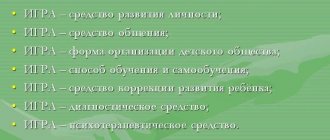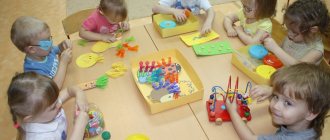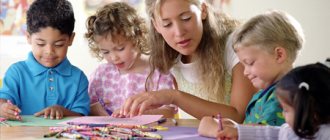Individual approach to raising and teaching a child in a kindergarten
The involvement of parents and other family members in the educational work of the kindergarten is necessary, first of all, for the children.
The success of cooperation largely depends on the mutual attitudes of the family and the kindergarten (V.K. Kotyrko, S.A. Ladyvi); they develop most optimally if both parties realize the need for targeted influence on the child and trust each other.
Positive results in raising children are achieved with a skillful combination of different forms of cooperation, with the active inclusion in this work of all members of the preschool team and members of the pupils’ families.
The forms of work can be very different - these are visits to families and children, open days, conversations, consultations, parent meetings, parent conferences. But priority remains with the individual form.
Thus, the following conclusions can be drawn: 1. Work both with the entire team of parents and individually with individual families can be successfully carried out only on the basis of knowledge of the characteristics of life and raising children in the family. 2. Factual material on the study of raising children in a family makes it possible not only to find out living conditions, but also to establish the reasons for the formation of individual qualities of children, to identify the connection between the conditions of upbringing, the formation of behavioral characteristics and the specifics of their manifestation. 3. Positive results in working with families can only be achieved if parents and educators reach unity of requirements in relation to children and all work is carried out according to plan and systematically. 4. It is necessary to give parents specific information on the issue of the age and individual characteristics of children, teach them to see the good in their children, and analyze the bad in their actions. 5. Along with general and individual forms of work with families, you can also work with several families that have similar conditions for raising children. 6. Studying the characteristics of family upbringing, as well as studying the characteristics of the child’s physical development, is a necessary condition for starting systematic work to implement an individual approach to children in raising and teaching them in various types of activities.
2. Psychophysiological aspects of an individual approach in the process of training and education.
In this test we will consider what psychophysiological aspects a teacher needs to take into account when taking an individual approach in the process of raising and educating a preschool child. The first aspect is the level of mental development. This aspect is one of the most accepted in pedagogical practice. When implementing an individual approach in the process of education and training in a kindergarten, the level of skills of the child, as well as the set of mental operations formed in the process of their acquisition, are traditionally studied. If the child’s mental development proceeds at an accelerated pace, this means that mental operations corresponding to his chronological age, he quickly perceives and comprehends the material, remembers and reproduces it faster, retains it more firmly in his long-term memory, and successfully uses the acquired knowledge in completing tasks. Cognitive interest here is very stable; it supports the child’s activity for a long time. An individual approach to raising and educating a child based on the level of his mental development today can only be built taking into account the zone of proximal development. In this case, the teacher differentiates not the task, but the measure of assistance to the child in completing it: some perform it independently and explain the progress to their friends or look for a rational way to complete it, others perform it according to a certain algorithm specified by the teacher and compose the same task, and still others receive step-by-step help with implementation. In this case, the task is the same in complexity for everyone. To organize such an individual approach to learning, it is not enough for a teacher to simply determine the amount of knowledge the child has; it is necessary to know the characteristics of his cognitive sphere, the maturity of cognitive actions and the level of the child’s learning ability. The second aspect is the type of nervous system. The individual characteristics of children can also be determined by the properties of the nervous system. According to modern concepts, the properties of the nervous system are of a genotypic nature and in this sense are understood as practically unchanged, stable characteristics of a person. This means that one cannot ignore individual typological characteristics and take them into account in pedagogical interaction. Among the main properties of the nervous system are the following: strength-weakness and mobility-inertia of the nervous system. The third aspect is the type of thinking. Children, like all people in general, think differently: for some, abstract, verbal-logical thinking prevails over figurative thinking. In this case, it is legitimate to talk about an analytical, “mental” mindset. In other people, imaginative thinking or, in other words, an artistic type of thinking predominates. For still others, the figurative and abstract components of thinking are in relative balance (harmonious mindset). These differences are based on the functional asymmetry of the cerebral hemispheres. The specialization of the hemispheres is facilitated by active mental activity, which in turn depends on how the work of the hemispheres is organized in the process of thinking. When implementing an individual approach, it is important for the educator to know which hemisphere provides the process of mental work and how, in order to effectively organize the process of training and education. Thus, the artistic type, that is, people with a dominant right hemisphere, is characterized by thinking based on vivid images that arise as a result of vivid perception and emotions. They think synthetically, grasping the entire object. They begin to comprehend the material with emotional inclusion, rely on ideas and images, and then move on to analyzing the components and drawing conclusions. In children of the thinking type, on the contrary, the thinking process begins with the analysis of components, with the construction of logical chains. They think in concepts, symbols, abstractions and logical reasoning predominate in them, and emotional coloring most often prevents them from thinking. It is pointless to talk about which type is better, since we are talking about the individual characteristics of a person. It is absolutely necessary to take them into account in the process of training and education. The fourth aspect is the Leading modality of perception. By observing the behavior of children, one can be convinced that the child’s way of understanding the world around him has a direct impact on the ability to adapt in society, on his physical development and, in the future, academic success. Knowing how a child learns about the world, one can with amazing accuracy assume or predict the problems that he will encounter in the future when studying at school. Considering that the way of cognition can be determined even in infancy, we can conclude that it is an innate characteristic of a person. Consequently, determining a child’s way of knowing is of great practical importance for parents, educators and psychologists, since it allows them to structure activities, games, and the learning process in such a way as to extract maximum benefit and pleasure from them and contribute to the development of the child. Thus, the following types of information perception can be distinguished: visual, auditory, kinesthetic. Visual type - the child learns through visual perception of information; auditory - through the perception of information by ear; kinesthetic - through the perception of one’s own activity. It is known that the priority of one or another way of cognition does not depend on age. A child's way of knowing will remain dominant throughout life, but empowerment only helps him make progress in each specific area. The fifth aspect is the state of health. The need for an individual approach to organizing the education and upbringing of children with physical defects and disorders of somatic development is beyond doubt today. However, psychological characteristics such as school neuroses, anxiety, fears, self-doubt and others are not always taken into account. Underestimation of these individual psychological differences and psychophysiological characteristics of children causes colossal harm to both the physical and mental development of the child. It is important for the teacher to know that in this case we are talking about mental health disorders, which are primarily associated with:
Individualization in preschool education according to the Federal State Educational Standard for Preschool Education
Individualization in education according to the Federal State Educational Standard for Education
In the general provisions of the standard
Clause 1.4. — the basic principles aimed at developing the individualization of preschool education are revealed. This includes amplification (enrichment) of child development and the construction of educational activities based on the individual characteristics of each child.
In the requirements for the conditions for the implementation of the basic educational program of preschool education
Clause 3.2.5. — the conditions necessary to create a social situation for the development of children are revealed.
- Creating conditions for children to freely choose activities; children making independent decisions;
- Expressing your feelings and thoughts.
- Supporting children's initiative and independence (play, design, research, cognitive, etc.).
Personalization
– the process of creation and awareness by an individual of his own experience, in which he manifests himself as a subject of his own activities, freely defining and realizing his own goals, voluntarily taking responsibility for the results of his activities.
It is wrong to equate individualization with an individual approach.
An individual approach
is the organization by a teacher of the educational process, taking into account the individual characteristics of the child. Identifying problematic or strengths in the child’s development and identifying ways for correction or further development. Let's try to compare individualization and an individual approach.
Let's consider the differences between the individualization of education and the individual approach in education.
We do not evaluate the child, but promote his development. We facilitate the child’s ascent along the “Ladder of Success” to the level of creative performance of activities and self-expression of their individuality.
“Ladder of Success” is a scientific and methodological tool that incorporates methods, forms, conditions, and results of the activities of the teacher and the child. It consists, figuratively speaking, of four “steps” that “rise from bottom to top.” Each “step” is built on top of the bottom one, indicating the next stage of the teacher’s work with the same child or the entire group of pupils.
THE FIRST, LOWER STEP INDICATES INTRODUCTION TO A NEW ACTIVITY.
This is a form of a group or individual show, an adult “theater”, in which the teacher is an “artist”, a “magician” (“Tom Sawyer who paints the fence”, etc.), and the child finds himself in the role of a “fascinated spectator”. The teacher’s goal is to awaken the child’s curiosity about the activity being demonstrated and to create a desire to learn how to perform it.
If a child finds himself in the role of a “fascinated spectator” and declares: “Teach me, I want to do this too,” then it means that the teacher has succeeded in his role. There is a well-known statement by philosophers that “you can’t teach anyone or anything until the person himself wants to learn!” L. S. Vygotsky formulated the same idea as follows: “the teacher’s program will only be assimilated by the child when it becomes the child’s own program.” .
The teacher uses this form of “performance” in different variations until the child is truly “fascinated and takes the initiative to learn, saying: “Teach me. I want to do that too.”
A child’s communication of his desire to learn to an adult is a fact confirming that the child has accepted the teacher’s program,” and has discovered the meaning of learning for himself. His plan for activity now coincides with the plan of the teacher.
The studies of the famous Ukrainian psychologist V.K. Kotyrlo revealed the dynamics of the development of cognitive needs*.
The first form of expression of this need is "curiosity".
An indicator of curiosity is the question “What is it?”
That is, for a child, the situation of entering the first level of cognition should be unintentional.
Assistance in the emergence of this emotion will lie in how skillfully the specialist arouses curiosity in the child in conditions when the teacher plays and communicates with him. The child’s perception of new cognitive material should occur in such a way that the preschooler experiences the emotion of joy.
The second form of cognitive need is “curiosity.”
It manifests itself in children’s questions “Why? For what? For what? etc.".
The third form of cognitive need is “cognitive activity itself.”
It takes place
in different types of
preschooler’s amateur activities: observation, looking at pictures, listening to a book, experimenting, testing, etc.
_____________________________
See Kotyrlo V.K.
Development of volitional behavior in preschool children. - Kyiv, Radyanska school, 1971.
THE SECOND STEP INDICATES THE TEACHER'S ASSISTANCE IN EACH CHILD'S MASTERING OF ACTIVITIES.
Dialogue becomes the condition and form of such ascent. Such a dialogue is indicated by the metaphor “delicious interlocutors.”
Promoting a child’s comfortable stay at this level should consist of a special atmosphere of communication that the teacher creates. A child, rising to the “second step,” expresses a desire to learn from an adult, but participates in communication with an adult as long as he likes the “food for his mind and heart” served by the adult. For a 3-4 year old child, communication time can be limited to two minutes, or can be extended to 10-12 minutes (if he performs productive activities). In older children, other temporary possibilities were found; moreover, from age to age, the need for individual communication for the sake of learning something new among preschoolers (especially boys) increases.
The second step is not easy, because the “start” is different for all children, and also the specificity of solving problems for boys and girls, besides, the temperaments and characters are different
In general, each child’s rate of ascent along this second step to the third, of course, is different. This means that the teacher’s acting palette is also different for each child, for each type of activity, moreover, at each level of its development by each child, and different for each!
The “task of a good conversationalist” will consist in the special behavior of the mentor as a patient optimist, ready every time to happily support the next attempt of a preschooler to learn from an adult.
Let's consider how the teacher's behavior changes depending on what level of cognition each of the pupils is at.
LEVEL
-
“A”
, The behavior of a child is characterized by the fact that he comes with the desire to fulfill what the adult has shown to the whole group of children, but he cannot repeat the program material. Therefore, the teacher must show him the “theater” again. You must be prepared for the fact that some of the children will need to watch the same thing not once, but several times, although at different times and in different situations. But in order for the pupil’s initiative attitude towards meetings with adults not to fade away, the skill of the senior interlocutor should be manifested in the ability to evoke an emotion of joy in the younger communication partner.
TRANSITION OF A CHILD TO LEVEL “B”
reflects the performance of activities under the direct supervision of an adult in accordance with the model. This level also reflects a person’s differentiated or multifaceted knowledge of the subject (phenomenon, activity) being studied. At this stage of training, the teacher takes on the role of a “tasty companion” and patiently works with the student individually: first, he again demonstrates a sample of the activity (level “a”), then the student, under his guidance, repeats it many times in accordance with the sample (level “b”). And finally, the moment comes when he says: “I’ll do it myself,” that is, he reaches the level of independence.
Since all children are different, it is difficult to provide as indicators of this level of development the pace and number of attempts that each child needs in order to confidently complete program material under the direct supervision and participation of a mentor. The second stage of cognition reflects the child’s need to repeatedly reproduce the learned material under the direct guidance of the person transmitting the experience (an adult, a peer, a book, etc.).
At this time, the teacher can also use a conjugate action, that is, an adult together with the child (acting, for example, with his hand) reproduces the cognizable material. There may also be several such attempts-exercises, but the main thing is that the initiative to repeat again comes from the child, who will strive to achieve a result that corresponds to the model.
Communication always ends with support and praise for the child’s slightest movement towards success. He should leave the adult with a feeling of “wings behind his back.” And tell the teacher: “I’ll come to you again.” And although a three-year-old child already knows that he must address the teacher as “You,” the transition to “You” shows that the adult has found the correct form of communication, and the child trusts him as a family member. At the same time, of course, this is not a one-time meeting; the stage can last a day, or two, or a week, until the child masters the material to level “B”, that is, completes it independently.
Since the teacher works on the basis of a technological project, he can and should plan in advance the work with children to master the material and begin to carry it out in a few weeks. Completion of preparation is determined by the day when a group-wide form is planned, which can be an activity (work, game) as a form of diagnostics of what has been mastered program material.
Having a scenario-based project development for the whole year allows the teacher to begin this long and difficult learning process in a timely manner in 2-3 months in order to have time to involve all the students in it.
LEVEL "B" OF THE SECOND STAGE
reflects a “generalized” perception of an object or phenomenon, when the student discovers its patterns and moves from reproduction under the guidance of a mentor to independent execution of actions.
Ascending to the level of amateur activity allows the child, firstly
, to discover the unknown in the well-known, and
secondly
, begin experimental
cognitive
activity on his own initiative
.
A child’s independent performance of an activity is an indicator of his appropriation of the experience of previous generations, but so far only in conditions of joint activity with an adult. To ensure the true level of mastery of an activity, new conditions are necessary, when the child performs the mastered activity in isolation from the adult - the technique of transferring the mastered knowledge to new conditions.
Each child will master the teacher’s program according to our project at his own pace. And only when all the pupils are able to perform this activity independently, and some of them are already creative, the teacher determines their readiness for the frontal form of teaching preschoolers.
The stage of the teacher’s work on the “second step” of the “Ladder of Success” in the role of a “delicious interlocutor” is truly creative for every teacher-performer. The speed of mastering the program content by each of their students, who manifest themselves uniquely, depends on his intuition, tact, patience, and acting palette.
The (intermediate) result is an ascent (by the majority of pupils) in mastering activities to a level of independence, which is characterized by initiative, autonomy from an adult and adequate self-esteem of the product of the activity. But even after a group lesson, “delicious interlocutors” will not part ways, because the goal of our communication is to promote each child’s mastery of this activity on a creative level.
AT THE THIRD STEP OF THE “LADDER OF SUCCESS” ALL PUPILS OF THE GROUP AT THE SAME TIME PARTICIPATE IN THE FORM OF ACTIVITY ORGANIZED BY THE TEACHER.
The teacher acts as a “conductor” or “director,” and the children are an “orchestra of caring performers.”
This form of collective interaction opens up for each child the opportunity to choose, predict success, use volitional effort, and experience the joy of cooperation. And for an adult, it also acts as a unique form of diagnosing each child’s ascent to the level of independence*.
The teacher’s goal: to promote the child’s self-affirmation in his abilities, in transferring his mastered skills into a collective, public form of expression.
The definition of “caring” emphasizes the moral orientation of the preschooler’s activities. And for an adult, the frontal form also becomes a form of diagnosing the mastery of program material by each participant.
Communication in classes is usually based on
with
the help of a game character:
in the younger and middle groups with “Mishka”, and in the older groups with “Dunno or “Klutz”. These characters (as explained by V.V. Stolin) serve as an external form of manifestation of the preschooler’s self-awareness: the child sincerely talks to the character who is making mistakes, answers the teacher’s questions in the same way as an adult talks to himself when, reflecting, analyzing an event, builds a dialogue with the intended interlocutor.
The teacher plays two roles simultaneously: his role as a mentor and his role as a character.
This requires acting skills and a rich intonation palette. Each participant in the lesson (not only the children, but also the teacher along with them) first laughs cheerfully at the stupid klutz, and then the children passionately argue with him, pointing out mistakes in his answers. Therefore, daily meetings with a character are a form of an optimistic attitude towards life, which has a beneficial effect on the health of pupils.
The character performs three functions in the lesson:
1) changes the position of the student, turns him from a student into a teacher of a klutz. By teaching another, the child asserts himself in his knowledge and skills, he develops an adequate self-esteem of the results obtained;
2) puts the child in a problematic situation, the signs of which were developed by psychologists and didactics A. N. Matyushkin, M. I. Makhmutov and others.
3) requires the child to make a contextual speech utterance in the form of a system of statements.
Schopenhauer’s famous aphorism: “He who thinks clearly, expresses clearly.” Thanks to individual training, preschoolers are prepared for complex forms of speech. S.L. Rubinstein formulated another important judgment: “By formulating a thought, we form it.” This emphasizes the positive impact of verbal communication with the character on the course of the child’s mental development.
*This understanding of the lesson as a form of diagnostics of mastery of the material achieved in individual training was proposed by A.P. Usova.
Playing with a klutz doll is a form and means of enriching the development of a child’s self-awareness and his self-affirmation as an individual.
FOURTH STEP OF THE “LADDER OF SUCCESS”
—
FORM OF INDIVIDUAL AND COLLECTIVE ORGANIZATION OF PRESCHOOL CHILDREN’S ACTIVITIES.
The teacher is a “fascinated spectator”, and the child is now an “artist”, architect, painter, researcher, etc. Now we have before us the “child’s theater”, his creative workshop.
According to V.S. Merlin, the child creates and maintains his individuality through his actions. At this stage of development, activity from an object of knowledge turns for the child into a form of being,
a form of creative self-expression of one’s individuality, self-improvement as a unique individual.
And the teacher now finds himself in the role of a “fascinated spectator.”
Now the teacher’s goal is to ensure that each student in the group performs program activities creatively, acquires his own unique style of performing it, and demonstrates his own special talents. The creative level of children’s amateur performances becomes for the teacher a means of promoting their diverse education and self-education.
Mastering the “Ladder of Success” means for the educator also mastering professional mental activity. This allows him to master the diagnosis of the level of development of each pupil in each type of activity, and on this basis determine his own role that he should play for one child or for children to perform at a given moment Whether he is now an “artist” or a “delicious conversationalist”, or a “conductor”, or a “fascinated spectator”. Therefore, the structure (system) of his activity will be built on a change in role behavior, and the execution of a technological project will manifest itself as improvisational, creative
.
Each stage of a child’s ascent up the steps of the “Ladder of Success,” and especially the fourth level of mastery of the activities of each of the pupils, reflects for the teacher the success of the result, the effectiveness of his professional activity, and an indicator of co-creativity.
both with the child and with his family.
- Formulation of plan, purpose, motive
- Selecting an item or material to transform an item
- Selection of implements or tools
- A system of actions that transform the material: what comes first, what comes next.
Model of teacher activity
The teacher can:
a) work in one of the centers;
b) move from center to center providing assistance;
c) move from center to center, observing the children’s activities;
d) observe a specific child
Development of subject-spatial environment
The organization of space is carried out according to the thematic principle, changing in accordance with the theme.







